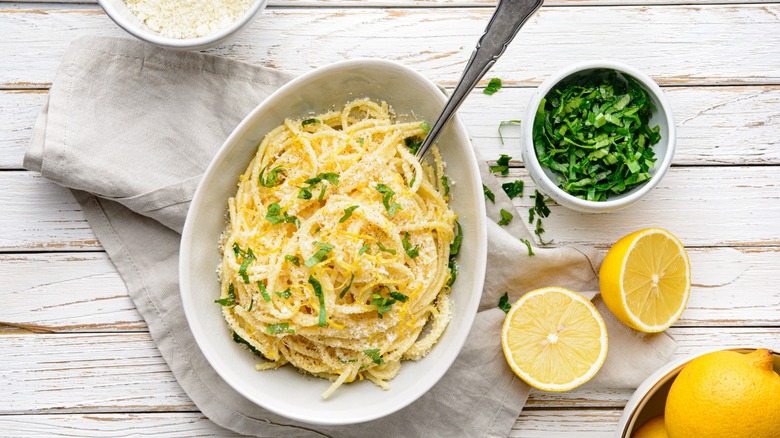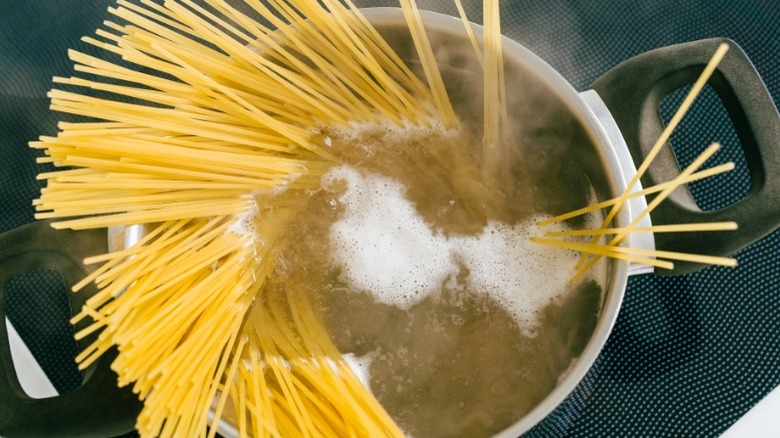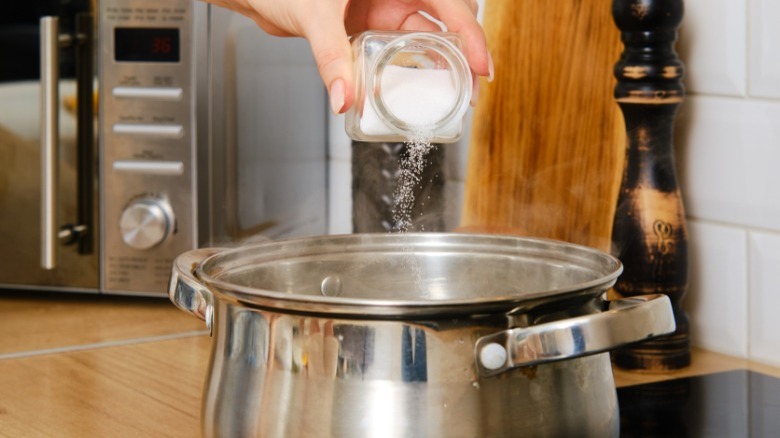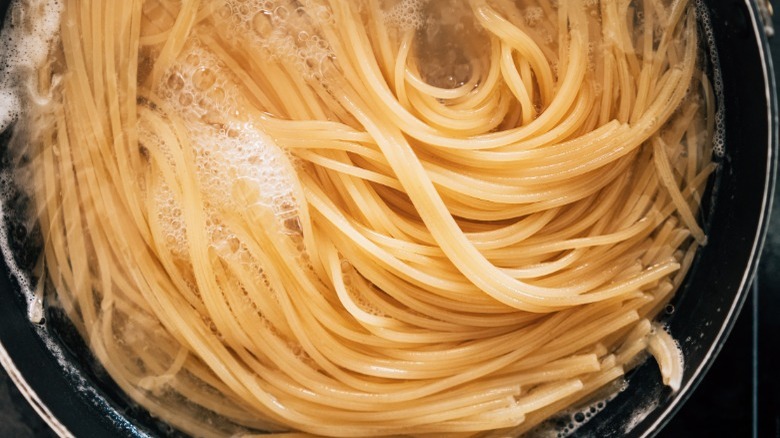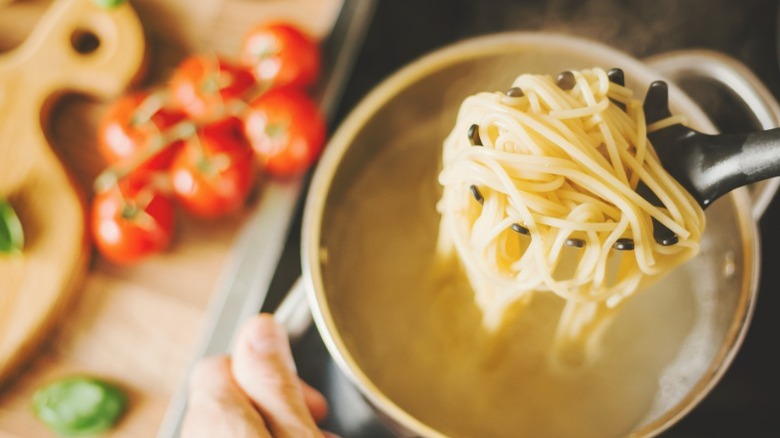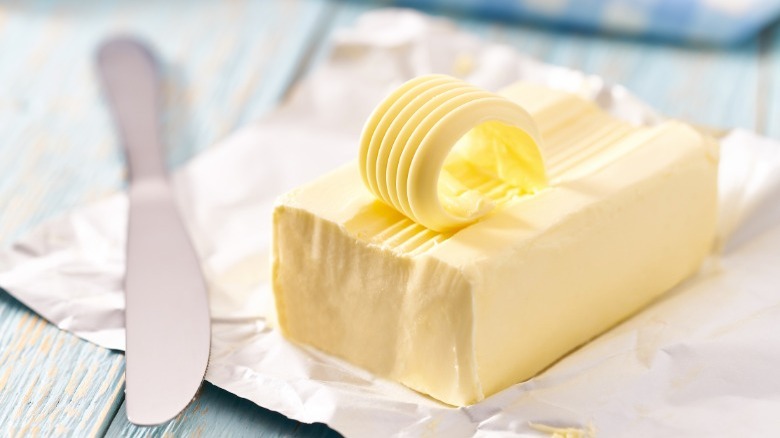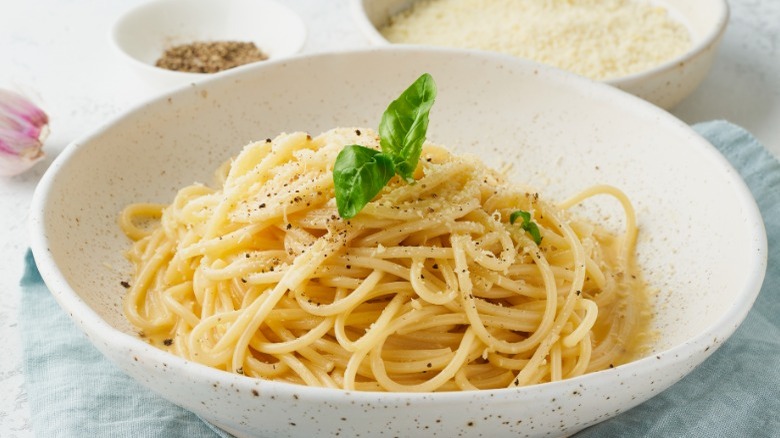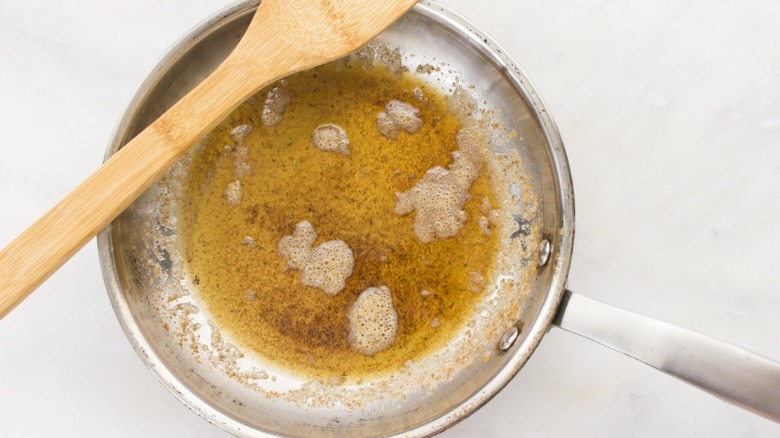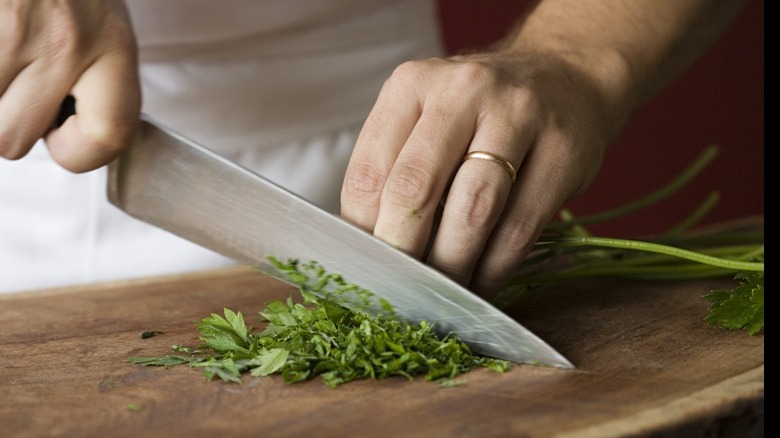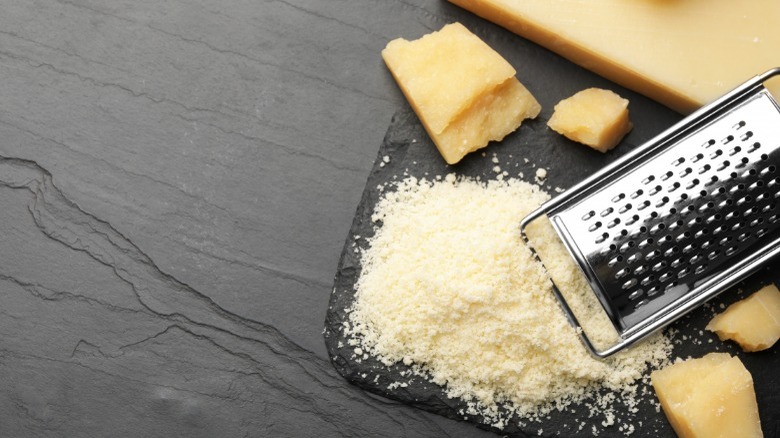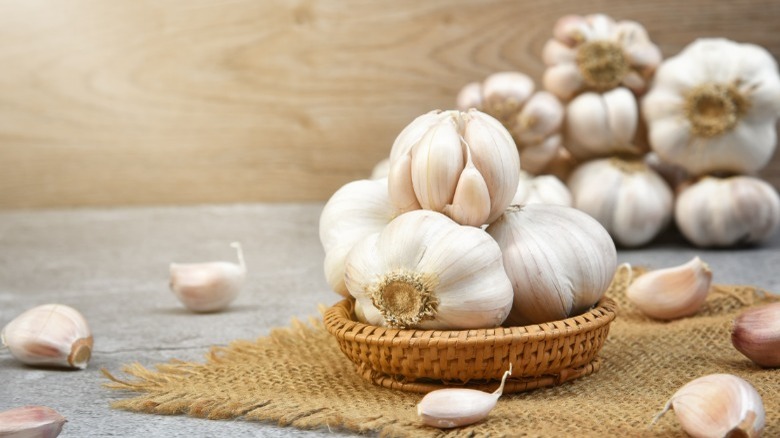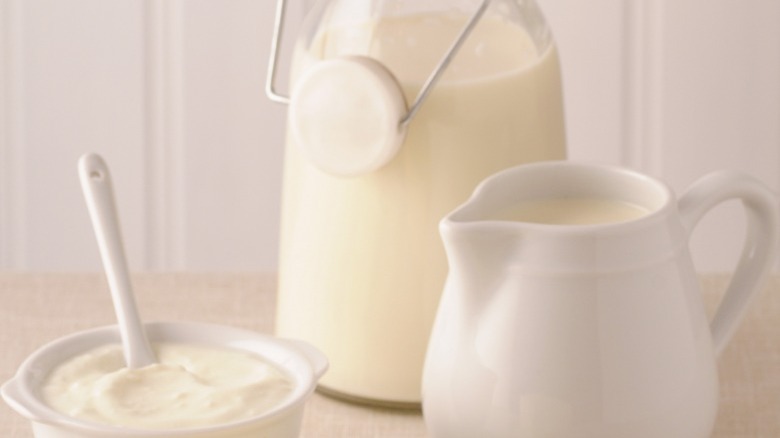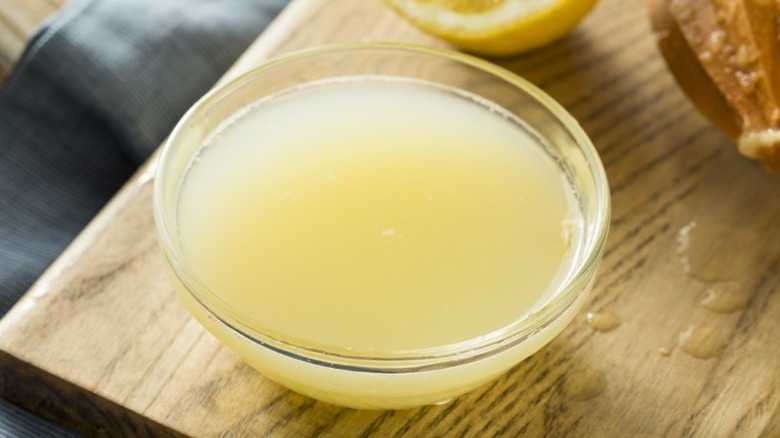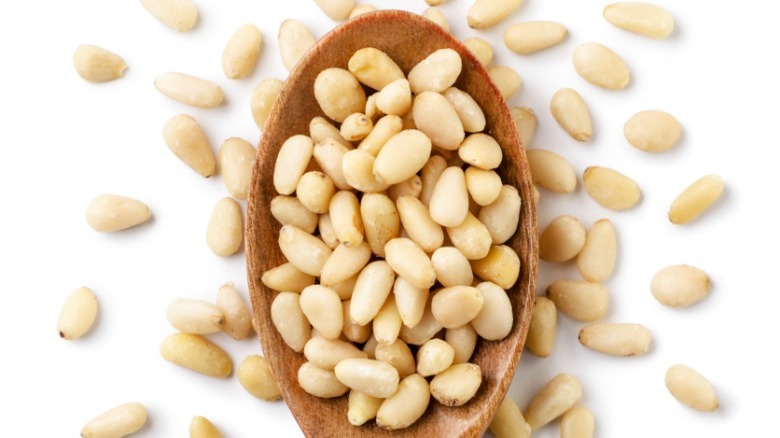14 Tips You Need For Perfect Buttered Noodles
Oh, buttered noodles. With such minimal ingredients, you can't help but wonder how just one bowl has the ability to give you all the foodie feels. For some, it's the gobs of butter intertwined between each strand of pasta that brings joy. For others, it's the comforting nostalgia that takes them back to the good old days.
The thing about buttered noodles, though, is that you really can't botch the meal. Sure, you might overcook your pasta or run out of butter along the way (those two situations are the worst), but it's kind of difficult to ruin such a modest dish.
There are, however, several ways to amp up your buttered noodles, and trust us when we tell you there are a few tips on this list that will seriously change your entire view on this humble kid-approved meal.
We know pasta and noodles aren't the same product — the ingredients, preparation, and texture differ significantly. But, for the sake of consistency, when we say buttered "noodles," we mean pasta and noodles. Whatever starchy carb-filled food your pantry is sporting works for the term if you ask us. So, let's get started.
Don't overcook your pasta
Whipping up a batch of pasta should be pretty straightforward, but believe it or not, you can make many mistakes along the way. Overcooking your pasta is probably the worst error — there's no fixing that tragedy. So, instead, here's how you can avoid it.
Luckily, there is a way to tell when your pasta is al dente, or "to the tooth." You want those starchy strands to be just a bit firm, and really the best way to know it's right is by taking a bite and giving it a try yourself. If you feel a slight crunch, your pasta needs more time in the bubbly hot bath.
After biting in, be sure to examine the noodle. If it is al dente, you'll notice the center of the pasta is a bit paler in color. The touch of white is a good indication that your pasta is al dente. There should be no crunch but rather a slight firmness to the bite.
Actual noodles are different. Sure, you want to avoid overcooking these too, but cooking instructions vary quite a bit, depending on what type you are making. So before bringing a large pot of water to boil, check the package directions first.
Remember to add salt to pasta water
Once you understand the fundamentals of pasta boiling, you will have no issue breezing through the mindless task while appreciating perfectly cooked pasta each time. One of the most basic yet vital tips for nailing pasta every time comes down to salting your water. You have likely been told to add salt to the water at some point in your life, but do you know why you are supposed to? Better yet, do you know how much salt you should add to your water?
You might be surprised to know that your pasta water needs way more salt than you probably think. According to expert Marcella Hazan, you should add 1.5 tablespoons of salt for every pound of pasta and add it once the water starts boiling. The main reason to properly salt water is to enhance the flavor of the pasta, and you never want to skimp out on flavor.
While you don't want it to taste like the Atlantic Ocean, at the very least you need to add enough to enhance the pasta's flavor. You'll appreciate the overall flavor of your buttered noodles (or any other pasta dish) more because each noodle has time to absorb the saltiness.
Use less water than usual
We know this might go against every tip you've ever read about boiling pasta but hear us out. The amount of water you use will make a huge difference when it comes to making buttered noodles.
Typically, you want to reach for a large pot and fill it with plenty of water before turning your heat up and bringing it to a boil. The ample space will give your pasta ample room to move without sticking. Ensuring your pasta does not stick is still very important, but making starchy water is crucial here too.
Since you are using less water than usual, stirring your pasta within a minute or two of adding it to your water is essential. Otherwise, it will clump up from the released starch, which naturally makes the pasta sticky. Make sure to use enough water for your pasta to fit, with plenty of room to plump up and double in size.
Save some of that pasta water
Whatever you do, do not get rid of your pasta water. The very reason we recommend using less water is to create ultra-starchy liquid, which will be put to good use. That starch-filled pasta water, combined with butter, will help make an incredibly saucy coating that will change everything you ever thought about buttered noodles.
Emulsification comes into play here. Water and butter, which are typically two substances that don't blend well, come together (or emulsify) beautifully thanks to the starch, which works like a binding agent. Together, the two create a bougie sauce your adult taste buds will no-doubt cherish.
Rather than dumping your pasta (and hot water) into a colander, turn off the heat and remove the pot from your heat source. Use a ladle or deep serving spoon to transfer at least a cup of hot pasta water into a separate bowl. Leave your pasta in the pot with the remaining water while your butter melts in a separate skillet. This will keep the pasta from sticking.
Use high-quality butter
So far, we've talked a lot about tips, tricks, and essential techniques for getting pasta right for buttered noodles. Now, it's time to talk about the one other most important ingredient — butter.
When perusing the butter section at your local grocery store, you'll notice plenty of options, which, of course, come with varied price differences too. The less expensive, lower-quality butters usually have more water content, while the pricier, high-quality butters boast a higher milk fat content. The higher milk fat provides better results in recipes, especially baked goods. When it comes to buttered noodles, the higher quality butters will lend to a much richer flavor and will no doubt take your buttered noodles from bland to brilliant.
If you're wondering which brands to look out for, we can help with that too. A few lucky Tasting Table reviewers took the time to sample the six most popular American grocery store butters and included one brand of margarine for good measure. Ultimately, Horizon was a first-place winner for its "unadulterated dairy flavor" and richness. So, if you can find that brand on your next grocery trip, throw a pack in your cart.
Add pasta to the butter
Typically, when you make any pasta meal, you drain your pasta, maybe give it a rinse, then add a bit of fat to keep it from sticking. When it comes to making buttered noodles, you'll need to forget about those amateur steps.
Once you taste-test the pasta and determine it needs another minute, begin melting your butter. Grab a large skillet, place it over medium heat, add a few tablespoons of butter, and let it melt.
Once your pasta is ready, save a bit of pasta water, then use a pair of tongs to transfer large portions over to the skillet. Hold your pasta over the pot while it drains just a bit before transferring it to avoid a hot splashy mess. This will help bring some of that critical pasta water to your pan and provide enough starch to help create a thick, emulsified sauce.
After transferring the pasta, you may consider adding a couple more tablespoons of pasta water to your pasta, depending on the consistency. If the sauce seems a bit on the thicker side, feel free to add some more. If it's already very watery, then hold off and continue warming it in a pan until it cooks down.
Consider browning your butter
If you've never tried brown butter, boy, are you in for a treat. Brown butter is butter that has been heated slowly in a skillet or saucepan until it becomes a nutty golden brown hue. But why would you want to turn your butter to a brown color?
Most of us do it accidentally by leaving it on high heat and forgetting it. The accidentally burnt butter is a bit different. A gently heated brown butter boasts an incredibly rich and nutty flavor that transforms most meals into something special. It's an ingredient you need to start using in more recipes, mainly because of the unique flavor it provides.
To make brown butter, you'll want to grab a white or light-colored pan. This helps you to see the butter turn from its pale yellowish-white hue to a darker brown color. Melt your butter over medium heat and watch as the butter slowly turns brown. This happens due to a chemical reaction that occurs when the sugar and protein in the butter are heated, thus creating a toasty warm flavor that will bring take your buttered noodles up a few notches.
Add fresh herbs
Culinary herbs sure have a way of brightening dishes, thanks to their fresh flavor and vibrant hues. You will especially love how fresh herbs add a lovely touch when making a big bowl of buttered noodles. Whether you have a fresh edible garden outside your door or always find yourself grabbing fresh bundles of chives or parsley at the grocery store, you'll love experimenting with them here.
Buttered noodles will love the addition of herbs like parsley, chives, basil, and sage. If you're giving brown butter a try, consider pairing that with sage for an extra fancy dinner. The two ingredients marry beautifully. You can even use fresh herbs to make compound butter, then melt that in your pan when ready to whip up a batch of buttered noodles. After all, you are the head chef in your kitchen — don't be afraid to experiment.
Grate cheese over the top
You probably already know about the wonders of cheese's effect on any pasta dish. Buttered noodles are no exception — the freshly grated dairy brings an additional punch of savory flavor while also adding a bit of contrast in texture. The tiny grates of cheese and velvety rich butter sauce provide a distinction that is sure to please your palate.
But keep in mind that your selection of cheese can drastically change your pasta dishes' flavor profile. While grating a small cube of fresh Parmesan over the top will bring a lovely and most-welcomed finishing touch, you won't get that with all cheeses.
Feta, fresh mozzarella, and goat cheese all offer a distinctively tasty flavor, but adding bolder flavored cheeses will change the entire profile of the dish. Hey, if that's what you're going for, grab whatever tub of fromage your fridge is sporting. However, if you're sticking to simple and genuine, don't veer far from grated hard cheese like Parmesan.
Add garlic for a new depth of flavor
Garlic is another well-loved kitchen staple that brings a bold and deep flavor to many pasta dishes. Next time you make buttered noodles, consider adding this subtly spicy and sweet aromatic to the batch.
While your butter is warming in the pan, grate one or two garlic cloves over the top using a Microplane. If you don't own a Microplane (gasp), mince the garlic with a chef's knife and add that to your warmed butter. Keep your heat low to ensure your garlic doesn't bounce around in the pan and burn you. You'll notice a new flavor develop in the garlic. While it packs a powerful punch when raw, the pungent flavor turns to a mellow sweetness that will go hand in hand with the savory butter sauce.
If you're not a fan of peeling garlic, consider searching frozen grocery store aisles for little trays of already minced cloves. The small frozen cubes are absolutely fantastic to work with, considering you don't have to peel, grate or mince them. Just pop a frozen clove-sized piece into your recipe, and voila.
Add a dash of heavy cream
You might wonder why we recommend adding even the smallest amount of heavy cream to your buttered noodles. The ingredient will surely change the entire outcome of your dish; we know this, but sometimes a little doctoring is in need.
For example, heavy cream will come in handy if you run out of butter. We don't recommend replacing butter with heavy cream, but rather adding a dash if your dish needs additional creaminess. The rich thickness will help provide extra fat that may be missing in this dish. Similarly, you'll find heavy cream helpful if you accidentally cooked off most of your pasta water and you need some liquid assistance to bring your dry dish back to life.
This creamy garlic butter pasta recipe is an ideal example of how you can bring heavy cream, butter, Parmesan cheese, and garlic to one pot to create a dreamy sauce. Sure, it's no longer a traditional buttered noodles dish at this point, but it is, at the very least, delectable.
Always finish with salt and pepper to taste
Ever seen the phrase "salt and pepper TT" in a recipe? The commonly coupled ingredients are often found at the bottom of an ingredients list in recipes, and there is a good reason for it. "TT" stands for "to taste," which gives you authority over how much salt and pepper needs to go in, depending on your taste profile.
In a dish like buttered noodles, you'll want to flavor your pasta with salt and pepper towards the end, but only after you've already given it a taste. This is especially crucial for salt. Remember that you are salting your water, so your pasta will absorb the salty flavor.
If you plan on using salted butter, there is additional sodium. Plus, if you top your noodles with Parmesan cheese, that's another layer of savor added with every swipe across your cheese grater. Taste as you go, and flavor until it is just right.
Lemon juice and zest will cut down on heaviness
There is something to be said about citrus ingredients added to savory dishes. Whether you're making a breaded seafood dinner or you're crafting a rich sauce to serve with your salmon and rice pilaf, lemons bring a unique touch.
Because the juice of a lemon is so invigorating, it helps flavor sauces by brightening them with a bit of acid. This is especially true for heavier, greasy dishes like rich buttered noodles. Because the lemon is acidic, the juice naturally helps cut down the greasiness while sharpening other flavors within the dish.
Next time you make buttered noodles, try giving them a quick spritz of lemon juice while emulsifying the pasta water and butter. The distinctive flavor of the lemon plus its acidity will enhance your dish and brighten it. Otherwise, consider zesting some of the lemon for a stronger, tangier touch.
Experiment with additional ingredients
A kitchen is a place for experimentation. You make the rules in your own kitchen, so be sure to try out new ingredients until you find some you love. Don't ever settle for a recipe if it doesn't fully meet your taste buds' expectations.
Buttered noodles are the perfect dish to explore with new ingredients because the meal doesn't call for much. If you have a jar of sundried tomatoes sitting on your fridge door, mince a few pieces up and add them to your dish. Bacon bits or a smidge of bacon grease will give your pasta a whole makeover thanks to its unique flavor and texture.
Pine nuts can provide a subtle crunch, and everything bagel seasoning will bring a plethora of fun flavors to explore. See what you already have at home, and make do. Who knows, you might even develop a new signature dish for everyone to enjoy.
